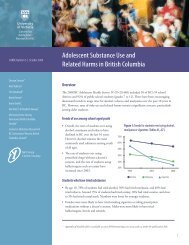A Review Of Research Into The Impacts Of Alcohol ... - CARBC
A Review Of Research Into The Impacts Of Alcohol ... - CARBC
A Review Of Research Into The Impacts Of Alcohol ... - CARBC
You also want an ePaper? Increase the reach of your titles
YUMPU automatically turns print PDFs into web optimized ePapers that Google loves.
1. International practice with alcohol and tobacco warning<br />
labels<br />
In 1997, the International Center for <strong>Alcohol</strong> Policies identified<br />
nine countries that had some kind of mandated alcohol<br />
warning label (ICAP, 1997), and since then at least eight other<br />
countries, or jurisdictions within countries, have passed laws<br />
requiring some form of alcohol warning labels (ICAP, personal<br />
communication), while others such as South Africa, Spain,<br />
Ireland, Australia and France are at various stages in the process<br />
of considering their introduction. Some other countries also<br />
have voluntary labelling in place, such as Japan where local<br />
brewers have elected to include messages warning about drinking<br />
during pregnancy. In Canada, the Yukon and the Northwest<br />
Territories have required liquor stores to provide warning labels<br />
on all bottles of wine and spirits as well as on packaged beer<br />
since 1992. <strong>The</strong> wording of existing warnings in other countries<br />
is, where available, displayed in Table 1 below. <strong>The</strong> translations<br />
used were provided by the International Center for <strong>Alcohol</strong><br />
Policies (1997, and personal communication). Countries where<br />
it is known that there is a warning label but for which the exact<br />
wording or an accurate translation could not be determined<br />
include Iceland and Armenia.<br />
In several countries, the requirement for warning labels has<br />
provisions to ensure their clear visibility. For example:<br />
• in Taiwan, the labels must be in a conspicuous place on the<br />
container’s largest external surface;<br />
• in Thailand, the label must be printed in bold characters at<br />
least 2 mm high;<br />
• in Mexico, the labels must be in contrasting colours;<br />
• in Guatemala, the label must be written in Arial Black size<br />
12 in capital letters, be clearly legible, and occupy 25% of the<br />
front part of the label; and<br />
• in Ecuador, the label must in an easily readable form, use<br />
colours that distinguish the text from the background, and<br />
occupy 10% of the total surface area of the label.<br />
<strong>The</strong>re are no such requirements for the better known (and<br />
researched) US warning label.<br />
<strong>The</strong> Australia and New Zealand Food Authority rejected a<br />
petition presented by the Society Without <strong>Alcohol</strong>ic Trauma in<br />
1998 for labels on all alcohol containers to carry the message<br />
that “alcohol is a dangerous drug”. However, since 1995, all<br />
alcoholic beverages sold in Australia have been required to have<br />
their alcohol content expressed in terms of numbers of “standard<br />
drinks”, each equivalent to 10 grams of ethyl alcohol (Stockwell<br />
and Single, 1997). <strong>The</strong> purpose of this kind of labelling was to<br />
support public health campaigns designed to promote low-risk<br />
alcohol consumption as defined by national drinking guidelines<br />
(Stockwell, 2001).<br />
Tobacco warning labels are far more widespread. By 1991,<br />
it was estimated that as many as 77 countries had mandated<br />
health warning labels on cigarette packets (Strahon et al, 1991).<br />
In Australia, substantial amounts of information about the<br />
health risks associated with smoking are provided on packets,<br />
along with simple messages such as “smoking kills”, “smoking<br />
causes lung cancer”, and “smoking harms unborn infants”. In<br />
Canada, graphic warning labels illustrating adverse health effects<br />
have been mandated which cover over 50% of tobacco packs<br />
(Hammond et al, 2003). <strong>The</strong>se are supplemented with more<br />
detailed information on the inside of the pack providing health<br />
risk information, encouragement to quit smoking, and tips on<br />
how to achieve this.<br />
A survey of 45 countries regarding tobacco warning label<br />
practices found that 40 had mandated labelling requirements,<br />
three had only voluntary labelling agreements with the local<br />
tobacco industry, and two had no agreements at all. Tobacco<br />
warning labels in developed countries tended to be larger and<br />
more specific than in developing countries.<br />
<br />
Centre for Addictions <strong>Research</strong> of BC





